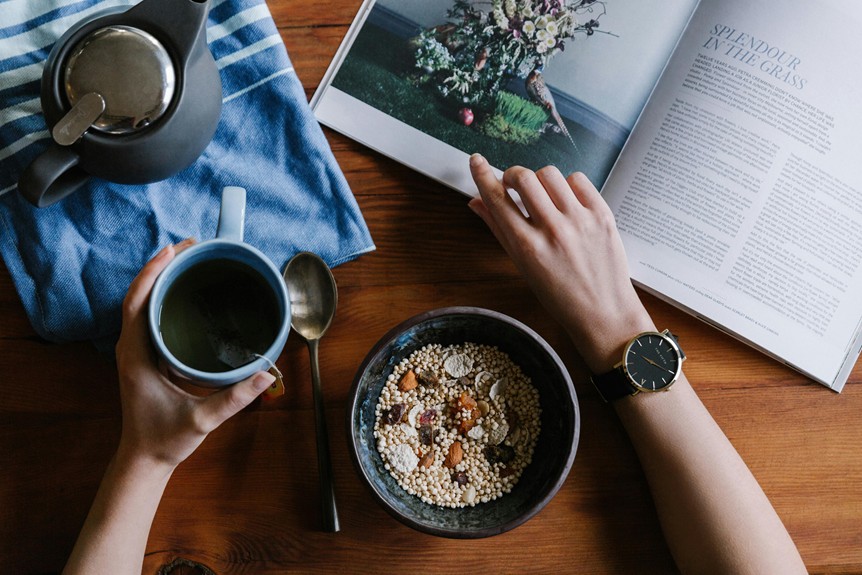Are Rolled Oats and Old Fashioned Oats the Same
Rolled oats and old-fashioned oats are fundamentally the same product, made from steamed and flattened whole oat groats. They have interchangeable labels in recipes, with a cooking time of approximately 10 to 15 minutes. Both retain a firm texture and shape when cooked, making them versatile for various recipes, including oatmeal and baked goods. Nutritionally, they provide about 150 calories, 5-6 grams of protein, and 4 grams of dietary fiber per 1/2 cup serving. With their similarities and benefits, understanding the nuances of rolled oats and old-fashioned oats can help you navigate oat varieties and make informed choices in your culinary pursuits.
Rolled Oats Vs Old Fashioned
While the terms "rolled oats" and "old-fashioned oats" are often used interchangeably, it is essential to understand the relationship between these two types of oats.
Rolled oats and old-fashioned oats are, in fact, the same product, both made from steamed and flattened whole oat groats. They share a similar cooking time of about 10 to 15 minutes and retain a distinct texture that provides structure and bite.
This texture makes them versatile and suitable for various recipes, including oatmeal and baked goods. The terms are often used interchangeably in recipes without affecting the final outcome considerably.
Rolled oats are often labeled as old-fashioned oats, reflecting their traditional processing method, further emphasizing their identical nature.
What Are Rolled Oats
Rolled oats, a staple in many households, are produced by steaming and flattening whole oat groats with rollers. This process is similar to that of old-fashioned oats, which is why the terms are often used interchangeably.
Rolled oats typically have a cooking time of 10 to 15 minutes, making them a versatile ingredient for various recipes. As a result of the rolling process, rolled oats retain their structure and bite after cooking, providing a chewy texture that many people enjoy in breakfast dishes.
As a whole grain, rolled oats are a nutritious choice, offering dietary fiber, protein, and essential nutrients. They are an excellent addition to a healthy diet, providing numerous health benefits due to their high fiber content and other essential nutrients.
Types of Oat Varieties
The versatility of rolled oats, with their chewy texture and ability to absorb liquid, makes them a popular choice for a variety of culinary applications.
Rolled oats, also known as old-fashioned oats, are a type of oat variety made from whole grain oat groats that are steamed and flattened for quicker cooking. Both rolled oats and old-fashioned oats typically require a cooking time of approximately 10 to 15 minutes, retaining their structure and texture.
This processing enhances their ability to absorb liquid, making them suitable for oatmeal, baked goods, and granola. The term "old-fashioned oats" is often used interchangeably with "rolled oats" in recipes and nutritional contexts, highlighting their similarity and versatility within the types of oats available.
Oatmeal Nutrition Facts
Nutritionally dense and wholesome, rolled oats and old-fashioned oats offer similar profiles, making them an excellent addition to a balanced diet.
Both types of oats contain approximately 150 calories, 5 grams of protein, and 4 grams of dietary fiber per 1/2 cup serving. Rolled and old-fashioned oats are low in fat, with about 2.5 grams of total fat, and are a good source of essential nutrients like manganese, phosphorus, and magnesium.
With a glycemic index of around 55, they are a healthy choice for blood sugar management. These whole grain oats are naturally gluten-free, although they may require certification to avoid cross-contamination during processing.
Cooking Methods Explained
With a solid understanding of the nutritional profiles of rolled oats and old-fashioned oats, it's time to examine the various cooking methods that bring out their full potential.
Rolled oats and old-fashioned oats are cooked using similar methods, as they are both steamed and flattened whole oat groats. On the stovetop, they typically require a cooking time of 10 to 15 minutes. A liquid ratio of 1:2 (oats to water or milk) is recommended for best results.
Both can also be prepared as overnight oats by soaking them in liquid for several hours. Additionally, rolled and old-fashioned oats can be used interchangeably when baking, although their texture may yield slightly different results depending on the recipe.
These versatile cooking methods make it easy to incorporate rolled or old-fashioned oats into a variety of dishes.
Choosing the Right Oats
When selecting the right oats for a particular recipe or dish, it is essential to take into account the types of oats available.
Rolled oats and old-fashioned oats are two popular options, often used interchangeably due to their similarities in texture and cooking time.
Understanding the unique characteristics of these oats will help inform the decision of choosing rolled oats over other alternatives.
Types of Oats
Choosing the right type of oats is essential for achieving the desired texture and consistency in various recipes.
Rolled oats and old-fashioned oats are two commonly used types, which are identical due to their identical processing method of steaming and flattening whole oat groats. These types of oats typically require a cooking time of 10 to 15 minutes, making them versatile for various recipes.
Rolled oats, or old-fashioned oats, retain a firm texture and structure, suitable for oatmeal, baked goods, and granola bars. Their larger surface area compared to instant or quick oats allows them to absorb moisture effectively in recipes.
Understanding the different types of oats can help prevent confusion when selecting ingredients for cooking or baking. This knowledge can aid in choosing the right oats for specific recipes.
Choosing Rolled Oats
Selecting the right type of oats can greatly impact the outcome of a recipe, and rolled oats, also known as old-fashioned oats, are a popular choice due to their versatility and desirable texture.
Rolled oats have a cooking time of about 10 to 15 minutes, making them a convenient choice for quick meals. They retain their structure and have a chewy texture, suitable for various recipes like oatmeal, baked goods, and granola bars.
- Rolled oats are ideal for recipes requiring moisture retention due to their larger surface area.
- They can be used interchangeably with old-fashioned oats in most recipes.
- Rolled oats are a good choice for recipes where a chewy texture is desired.
- Their moderate cooking time makes them suitable for a variety of meal preparation needs.
Steel Cut Oats Difference
Steel-cut oats diverge significantly from rolled oats regarding texture, cooking time, and flavor profile.
Steel-cut oats are made by chopping whole oat groats into smaller pieces, resulting in a coarser texture compared to rolled oats. The cooking time for steel-cut oats is longer, taking 20-30 minutes, whereas rolled oats cook in 5-10 minutes.
Steel-cut oats retain more of their natural shape and nutty flavor, whereas rolled oats are softer and creamier. Despite their differences, both steel-cut and rolled oats are nutritionally similar, being whole grains that are low in fat and high in fiber and protein.
In comparison to old-fashioned oats, steel-cut oats provide a heartier texture, making them ideal for a rustic porridge.
Instant Oats Vs Rolled Oats
While steel-cut oats offer a unique texture and flavor profile, instant oats and rolled oats provide distinct options for those seeking more convenient or traditional oatmeal experiences.
Rolled oats, often considered synonymous with old-fashioned oats, require a longer cooking time compared to instant oats. Instant oats, however, may contain added sugars or flavorings in pre-packaged varieties, affecting their nutritional value.
- Instant oats are often finer and more processed, resulting in quicker cooking times.
- Rolled oats maintain a chewy texture and retain their shape better in recipes.
- Both instant and rolled oats are good sources of fiber, protein, and essential nutrients.
- Rolled oats are preferred in recipes requiring a firmer texture, such as cookies or granola.
Oat Texture and Cooking Time
Variability in oat texture and cooking time greatly impacts the overall oatmeal experience.
Rolled oats and old-fashioned oats, being fundamentally the same product, have a similar texture profile and cooking time. Typically, they take 5 to 10 minutes to cook on the stovetop, retaining a firm texture and shape when cooked.
Rolled oats have a slightly thicker and chewier consistency compared to quick oats. Their larger surface area enhances liquid absorption, resulting in a heartier oatmeal. This characteristic contributes to their popularity in oatmeal, baking, and granola.
The texture and cooking time of rolled and old-fashioned oats provide a reliable and versatile base for various recipes, making them a staple in many households.
Benefits of Whole Grain Oats
Whole grain oats, including both rolled and old-fashioned oats, offer numerous health benefits due to their nutrient-rich grain content.
The retention of the bran, germ, and endosperm in whole grain oats provides essential nutrients and dietary fiber, contributing to overall health.
Nutrient-Rich Grain Content
One of the most significant benefits of both rolled oats and old-fashioned oats is their nutrient-rich grain content, stemming from the fact that they are whole grains that retain the bran, germ, and endosperm from the original oat groats.
This makes them a valuable source of fiber, protein, and essential nutrients.
Key nutrients found in rolled oats and old-fashioned oats include:
- High amounts of soluble fiber, which supports heart health
- Approximately 6 grams of protein per 1/2 cup (dry), aiding in muscle health and satiety
- Important vitamins and minerals such as manganese, phosphorus, magnesium, and iron
- Antioxidants and a low glycemic index, which contribute to overall nutritional wellness
Lowering Cholesterol Levels
Considerable evidence supports the notion that consuming rolled oats and old-fashioned oats can have a profound impact on lowering cholesterol levels, primarily due to their high soluble fiber content.
The soluble fiber in whole grain oats, particularly beta-glucan, can lower total cholesterol levels by 5-10% and reduce LDL (bad) cholesterol, a key factor in cardiovascular health.
Studies have shown that incorporating 3 grams of soluble fiber from oats into daily diets can lead to a 7% decrease in LDL cholesterol levels.
Replacing refined grains with whole grain oats is an effective way to manage cholesterol levels and reduce the risk of heart disease.







